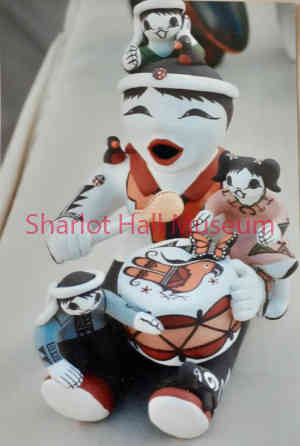By Emily Lane
Every piece of pottery tells a tale. The unique Native American art form known as storyteller pottery does so both literally and figuratively.
 A clay figure of a grandmother sits, the smaller figures of children all around her. Her mouth is open as she sings and tells stories of their culture and heritage, imparting spirituality and the important lessons of life. Three children and their dog, finely sculpted from clay, peer into a small bowl to find a turtle resting at the bottom. The children have slingshots in their back pockets; they are hunting for a rabbit but have found a turtle instead.
A clay figure of a grandmother sits, the smaller figures of children all around her. Her mouth is open as she sings and tells stories of their culture and heritage, imparting spirituality and the important lessons of life. Three children and their dog, finely sculpted from clay, peer into a small bowl to find a turtle resting at the bottom. The children have slingshots in their back pockets; they are hunting for a rabbit but have found a turtle instead.
A grandfather sings and holds a drum with children gathered round, listening as he teaches them the traditions of their people. The drum he holds symbolizes the heartbeat of Mother Earth.
It’s said that in 1964 a member of the Cochiti Pueblo (near Santa Fe, New Mexico), Helen Cordero, created the first storyteller to honor the oral traditions through which Native American culture has been passed down to younger generations for centuries. Storytelling is often used to teach children traditional beliefs and values. Other artists remember their grandmothers making similar figures but say that Ms. Cordero was the first artist to bring storytellers to market. Over the years, more artists from different Pueblos began producing storytellers in an increasing variety of styles. Many artists today learned the craft from their grandmothers and continue the tradition by teaching their children and grandchildren the art of pottery.
A piece of storyteller pottery might involve a grandmother or grandfather figure with at least 2 children (often many more), or it might depict animals. Many artists also make beautiful nativity sets. Today potters in about 13 Pueblos create storyteller pottery, each with their own perspective, but always with a deep sense of spirituality and respect for traditions, their culture, and for nature. It is nature, after all, that provides the artists with raw materials.
 Clay is hand-dug from the earth, from locations often very difficult and precarious to access. Most artists dig their own clay, many enlisting family members to help. An offering of food and water to “Mother Clay” may be left in thanks for material that’s been gathered. The clay is processed by sun-drying it for about a week, then soaking it in water, forming it into patties to dry again and then grinding the dried patties and soaking once more. Ground-up shards of old pottery are added to the clay as temper during this process. Temper keeps the clay from cracking during the firing process. The clay is hand-sculpted, sometimes using the traditional “hand-coil” method, where a piece of clay is rolled into a “rope,” which is then coiled to form a piece.
Clay is hand-dug from the earth, from locations often very difficult and precarious to access. Most artists dig their own clay, many enlisting family members to help. An offering of food and water to “Mother Clay” may be left in thanks for material that’s been gathered. The clay is processed by sun-drying it for about a week, then soaking it in water, forming it into patties to dry again and then grinding the dried patties and soaking once more. Ground-up shards of old pottery are added to the clay as temper during this process. Temper keeps the clay from cracking during the firing process. The clay is hand-sculpted, sometimes using the traditional “hand-coil” method, where a piece of clay is rolled into a “rope,” which is then coiled to form a piece.
Paints for decorating the pieces are made from natural materials, too. Different types of rocks containing minerals such as hematite or iron oxide are soaked in buckets of water to obtain the desired pigments. Some artists prefer using rainwater, as the alkaline water typical of the desert Southwest can alter the paint pigment and even corrode the pottery over time. On many Pueblos, water is hauled from the source and is a precious commodity. Traditional brushes made from the yucca plant may be used to apply the paints. Smooth stones are used to burnish the piece smooth for painting. When the piece is ready to be fired, cow or sheep dung is often used for fuel in the pit-firing process.
Storyteller pottery is not only beautiful to look at, it represents the spirit and proud heritage of the artist and the earth from which it sprang.
“Days Past” is a collaborative project of the Sharlot Hall Museum and the Prescott Corral of Westerners International (www.prescottcorral.org). This and other Days Past articles are also available at https://www.sharlot.org/articles/days-past-articles.l. The public is encouraged to submit proposed articles and inquiries to dayspast@sharlothallmuseum.org. Please contact SHM Research Center reference desk at 928-445-3122 Ext. 2, or via email at archivesrequest@sharlothallmuseum.org for information or assistance with photo requests.
Visit several storyteller artists and see their work on Sharlot Hall Museum’s virtual Prescott Indian Market at https://www.sharlothallmuseum.org/piam-2020.


